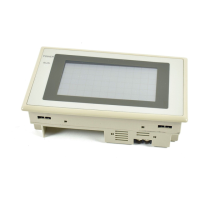7
Functions of NT20S
Section 1-2
1-2-3 Comparison between NT20S and NT20M
The NT20S is a unitary PT which incorporates a system ROM, screen memory,
and a host I/F unit (Host link, NT link, RS-232C, and C200H direct communication)
as the standard equipment in one body.
The NT20S has the following features which are different from those of existing
NT20M;
Function NT20S NT20M-DT121-V2
Communication S Host link/NT link incorporated
NT20S-ST121-EV3
S C200H direct communication incorporated
NT20S-ST122-V1
S RS-232C incorporated
NT20S-ST128
(other host I/F units cannot be connected)
Host I/F units are required.
Communication connector S The communication connector (9-pin) for a
Host is shared with that for a support tool.
(NT20S-ST121-EV3/ST128)
S Connectors for support tool (9-pin) and Host
connections on the rear face
(NT20S-ST122-V1).
The support tool connector (9-pin) is located
on the front side. The Host connector (25-pin)
is located on the back side.
Host RUN input terminal/
Alarm output terminal
Not provided Provided
System keys Not provided Provided
Contrast control Back side Front side
Waterproof performance Conforms to IP65. Conforms to IP54F.
Visibility in direct sunlight Excellent Average
Allowable momentary
power interruption time
Not guaranteed 5 msec
System ROM Built in (not replaceable) System ROM compatible with host I/F unit is
required.
Resume function Not provided Provided
History retaining function Not provided Provided
Screen transfer f f (Only possible if screen data memory is an
SRAM)
Screen data compatibility f (Note) –
PC ladder compatibility f –
Backlight replacement f Possible with NT20M-DT131.
Screen data memory Built in (flash memory only) Optional (select from EP-ROM, SRAM, and
EEP-ROM)
Screen data memory
capacity
96KB 128 KB max.
Outside dimensions 190 110 58mm 220 110 82mm
Note: If a system key function is required on continuous screens or for numerical setting
or buzzer stop, use a support tool and set the touch switches which have the sys-
tem key function in such screens.
For details, refer to “System Key Functions” on page 139.

